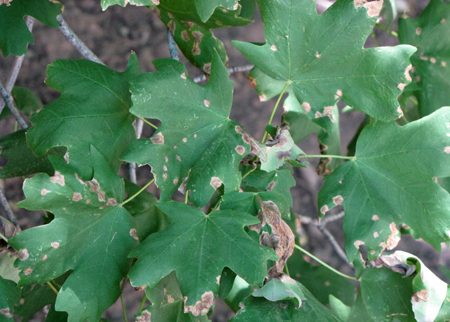Integrated Pest Management
Anthracnose
Apiognomonia spp.; Discula spp.; Kabatiella spp.
Hosts, Symptoms & Signs
- sycamore, maple, oak
- all three species show irregular-shaped necrotic lesions on leaves often on veins or on the margins
- on sycamore, new shoots show wilting and dieback
- cankers can develop on branches and trunk
- clusters of dead and live branches may form “witches’ brooms” from repeated dieback
- premature leaf drop late spring/early summer on maple and oak
- dieback of newly emerging shoots and expanding leaves on oak
Disease Cycle
- overwinters in buds, twigs, fruit, fallen leaves or petioles depending on host and anthracnose species
- spores are water- or air-dispersed during leaf expansion, especially during spring rains when temperatures are 50-68 degrees F
- infected leaves can spread disease to other leaves during rain events throughout the growing season
IPM Recommendations
- Manage trees to improve or maintain overall health.
- Rake and destroy fallen leaves to remove overwintering inoculum.
- Prune out dead branches or branches with cankers.
- Water and fertilize as necessary to maintain tree vigor.
- Apply preventative fungicides before leaf buds open, then every 10 to 14 days until disease conditions become unfavorable.




